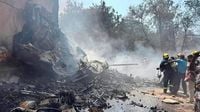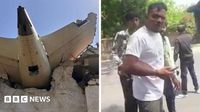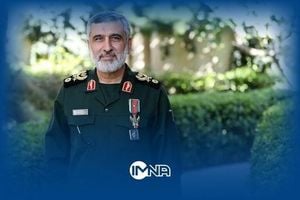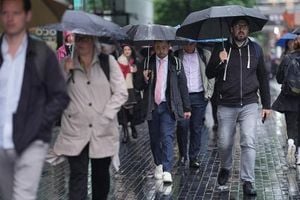On Thursday, June 12, 2025, tragedy struck near Ahmedabad, India, when Air India Flight AI171, a Boeing 787-8 Dreamliner en route to London Gatwick Airport, crashed just seconds after takeoff from Sardar Vallabhbhai Patel International Airport. The devastating accident claimed the lives of at least 290 people, including passengers aboard the plane and individuals on the ground, making it India’s deadliest air disaster in nearly three decades.
The aircraft was carrying 242 passengers and crew members, including 230 passengers and 12 crew. Among those onboard were 169 Indian nationals, 53 British nationals, seven Portuguese nationals, and one Canadian national. The plane crashed into a densely populated residential area known as Meghani Nagar, striking the dormitory of B.J. Medical College and Hospital, where students were sitting down to lunch at the time of impact.
Witnesses and officials described scenes of utter devastation. The crash site was littered with mangled aircraft debris, charred vehicles, and twisted metal fragments, some of which were embedded between the floors of nearby buildings. Passengers’ luggage was scattered across the wreckage, and thick black smoke billowed into the sky as firefighters and first responders rushed to the scene. Emergency crews arrived within minutes, but the scale of destruction was overwhelming.
Among the victims on the ground were medical students and staff residing in the hostel, with reports indicating that between 50 and 60 students were admitted to local hospitals following the crash. Tragically, some residents and relatives remain missing, and one resident’s wife was found dead. The death toll includes minors, local residents, and people inside the medical college’s dormitory.
In the midst of the devastation, a remarkable story emerged: the sole known survivor of the crash, British national Vishwash Kumar Ramesh. Sitting in seat 11A—located in the emergency exit row just in front of the plane’s left wing—Ramesh was slightly injured and hospitalized. Speaking from his hospital bed, he recounted, “Thirty seconds after takeoff, there was a loud noise and then the plane crashed. It all happened so quickly.” He described being surrounded by bodies and debris upon regaining consciousness, likely suffering from post-traumatic amnesia. Dr. Rajnish Patel, head of surgery at Ahmedabad Civil Hospital, confirmed Ramesh’s condition as “not very critical” and noted that he could be discharged within a couple of days pending legal and procedural formalities.
Ramesh’s family, based in Leicester, England, expressed both relief and heartbreak. His youngest brother, Nayan Kumar Ramesh, 27, shared the family’s shock and grief, saying, “You can see the state of my mother. I have got no words to describe it.” The family had planned a reunion upon their return and awaited news of Ramesh’s brother, Ajay Kumar Ramesh, who was also onboard but whose fate remains unknown. The British Member of Parliament for Leicester also spoke to the family, acknowledging the profound impact on the local Gujarati community, which frequently uses the Ahmedabad-London flight route.
The crash also claimed the life of former Gujarat Chief Minister Vijay Rupani, a prominent member of Prime Minister Narendra Modi’s Bharatiya Janata Party. Rupani was reportedly traveling to London to meet his family. His death was confirmed by Indian officials and mourned widely. Other notable victims included British nationals Akeel Nanabawa, his wife Hannah Vorajee, and their young daughter Sara, who were returning from a family visit in Gujarat.
In response to the catastrophe, Air India, owned by the Tata Group since 2022, expressed deepest condolences and deployed a team of caregivers to support grieving families and assist local authorities. The Tata Group’s chairman, Natarajan Chandrasekaran, pledged compensation of ₹1 crore (approximately $116,868) to the families of the deceased and committed to covering medical expenses for the injured and rebuilding efforts for the damaged medical college hostel.
On the international stage, the tragedy drew widespread sympathy. UK Prime Minister Keir Starmer described the crash as “absolutely devastating” and confirmed that a UK investigation team had been dispatched to India. The UK Foreign Secretary chaired a Cobra meeting to coordinate the government’s response, including consular support for British families. The Canadian Prime Minister Mark Carney expressed devastation over the loss of Canadian dentist Nirali Sureshkumar Patel, the sole Canadian national confirmed among the victims. US President Donald Trump offered support and pledged assistance, while the US Department of Transportation and National Transportation Safety Board (NTSB) sent investigators to aid the probe. The UK Air Accidents Investigation Branch (AAIB) also deployed a multidisciplinary team in accordance with international protocols.
Indian authorities swiftly launched a formal investigation led by the Aircraft Accident Investigation Bureau (AAIB), with participation from international partners including the US, UK, and Boeing, the aircraft’s manufacturer. The investigation aims to recover and analyze the plane’s black boxes to determine the cause of the crash. Early observations suggest the plane struggled to gain altitude, reaching a maximum height of just 625 feet before losing signal. Videos show the aircraft’s nose pitched upward with landing gear extended—an unusual configuration shortly after takeoff that experts say could indicate technical or procedural issues.
Safety experts emphasize that takeoff and landing are the riskiest phases of flight, requiring precise maneuvers and protocols. The Boeing 787 Dreamliner, introduced commercially in 2011, had not experienced a fatal accident until this crash. The aircraft involved was 11 and a half years old, with over 41,000 flight hours and nearly 8,000 takeoff and landing cycles.
Within India, the crash has prompted calls for strengthening aviation safety. A high-level committee of experts has been constituted to examine the incident in detail and recommend measures to prevent future tragedies. The government and local communities have mobilized to support victims’ families, with prayer services and vigils held across London and India, particularly within the British Indian community closely connected to Gujarat.
The human cost of this disaster is profound, touching families across continents. As investigators work to unravel what went wrong, communities mourn the loss of loved ones and cling to hope for answers. In the midst of sorrow, the survival of Vishwash Kumar Ramesh stands as a poignant reminder of resilience amid overwhelming tragedy.





